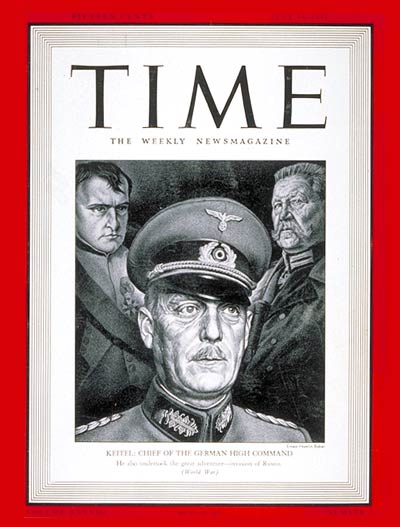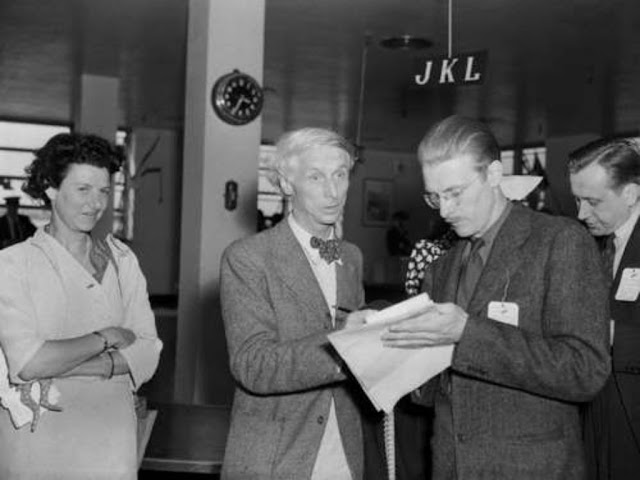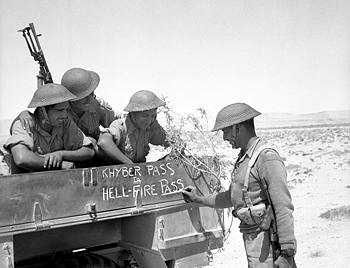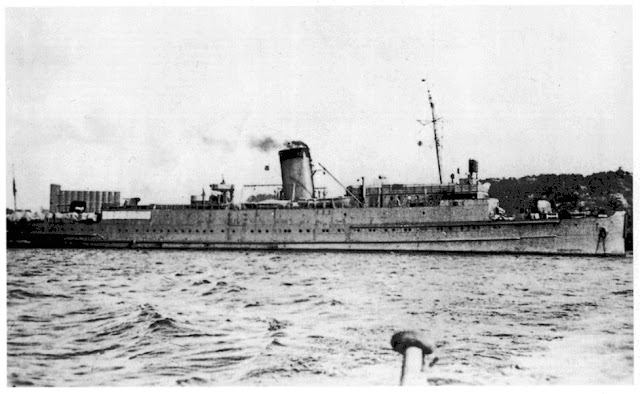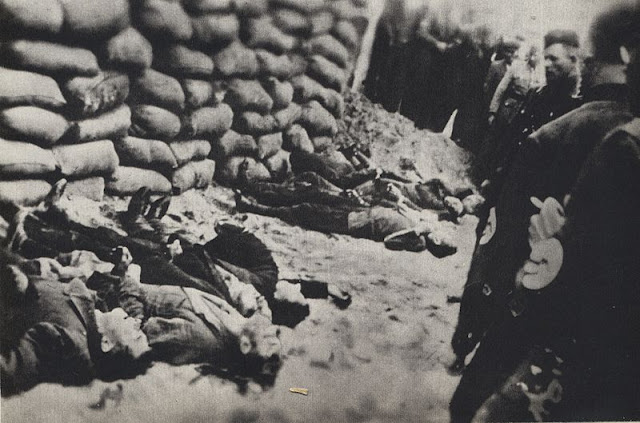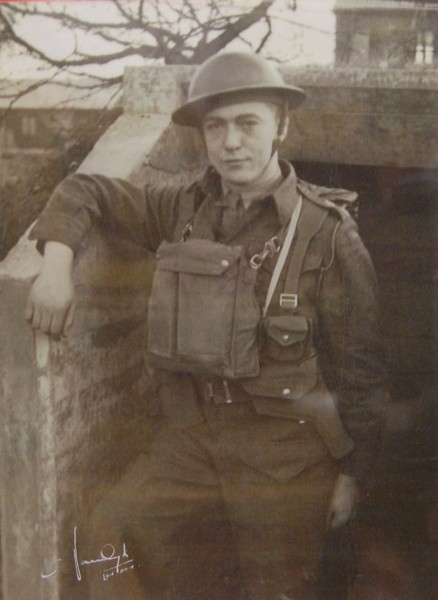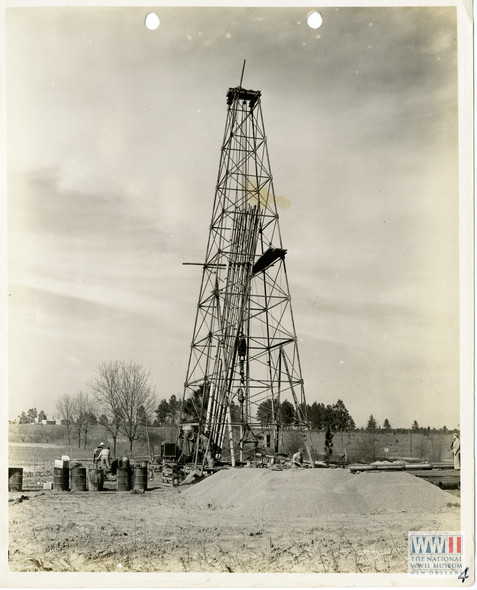Eastern Front: The spearheads of Army Group North reach the Luga River on 14 July 1941. The Luga is the last natural barrier before Leningrad. Leningrad is of top priority because the Finns are coming down on the other side, and linking up with them would free up a lot of formations. However, the real action is in the south, where a major battle appears to be shaping up around Kyiv.
In the Far North Sector, German General Dietl's attempt to get the advance toward Murmansk moving again fails as the Soviets land the 325th Rifle Regiment at the Bay of Litsa for a counterattack against German Army of Norway. Further south, however, the Finns continue making progress in Karelia. Their Army of Karelia takes the important road junction of Loimola and Muanto northeast of Lake Ladoga, sending the defending Soviet 7th Army and 23rd Army reeling back toward the lake. With the Wehrmacht advancing toward Leningrad swiftly from the southwest, Soviet forces in Karelia stand a good chance of being cut off.
In the Army Group North sector, German commandos of the Brandenburg special forces unit don Red Army and drive up in captured Soviet trucks in a daring operation to capture twin bridges at Porechye over the Luga River. Soviet Luga Operational Group counterattacks but cannot dislodge the Germans. German 6th Panzer Division takes a bridgehead over the Narva River. Soviet 11th Army, which has under command 41st and 22nd Rifle Corps and the 1st Mechanized Corps, counterattacks at Soltsy after Hoepner's 4th Panzer Group takes it. General Hoepner's 4th Panzer Group advances into the Lake Peipus area, while General von Manstein attacks toward Novgorod.
In the Army Group Center sector, the Soviets deploy an experimental battery of seven Katyusha mobile rocket launchers for the first time near Orsha/Smolensk in Vitebsk Province. The goal is to recapture a railway station with two Soviet ammunition trains. Under the command of Captain Ivan Flyorov, the unit fires two volleys of 16-rockets each. The barrage destroys the advancing German unit of tanks and armored vehicles and chases them out of the town, enabling the Soviet recapture of the trains. This successful introduction causes the Red Army to expand the use of the Katyushas and organize new Guards mortar batteries for the support of infantry divisions (Guards units are those that have been honored for some success on the battlefield and given extra units). This use of Katyusha rockets is a tonic to Soviet morale and ushers in an entirely new class of weapons - mobile rocket launchers.
General Guderian's 2nd Panzer Group continues to roll eastward and, late in the day, reaches the outskirts of Smolensk. His troops report that some of the enemy troops are running away "in wild flight," according to General Halder's war diary, but also some Soviets are trying to hold their positions. A Soviet counterattack centered on Gomel begins on the south flank of the army group, apparently to relieve pressure on Smolensk. General Hoth's 3rd Panzer Group heads toward a major Soviet troop concentration centered at Nevel.
In the Army Group South sector, a Soviet counterattack at Zvyagol gains steam. OKH sends the 25th Motorized Division and the SS Adolf Hitler Division to clear the Zvyagol/Zhytomyr highway. This is an important conduit to III Corps further up the road, which already is under pressure itself and running low on ammunition. Elsewhere on the front, the heavy fighting at Berdichev is dying down, with 11th Army having taken 2000 casualties. Outside of Kyiv, the 13th Infantry Division cuts railroad lines into Kyiv from the west and south.
Syrian/Lebanon Campaign: The Armistice of Saint-Jean d'Acre (also known as the "Convention of Acre") is signed at the Sidney Smith Barracks on the outskirts of the city of Acre. The armistice agreement provides that the 37,563 Vichy French military and civilian personnel in the Levant will be repatriated to France in eight convoys in August and September. The French can retain their side-arms and remain in their units, but their equipment is handed over to the British victors. The Armistice provides that local levees of Syrian and Lebanese volunteers, organized as the Special Troops of the Levant, remain free and simply revert to British command.
An exchange of prisoners also is required, but the British are upset when they learn that the French took many prisoners out of the country. Demanding their return, the British hold Vichy commander General Henri Dentz and 29 of his senior officers in detention in Palestine until they are handed over.
The Convention of Acre effectively ends the campaign in Syria and Lebanon. From a strategic perspective, this is a big win for the Allies because it ensures the safety of the oil route from Basra/Baghdad in Iraq to Haifa, Palestine. It also removes the threat of a concentric attack on Egypt should General Rommel's Afrika Korps make further advances.
European Air Operations: During the day, RAF Bomber Command sends 29 Blenheim bombers on a coastal sweep all the way from Cherbourg to the Netherlands. They wind up in a Circus mission at the Hazebrouck railway yards after attacking several targets along the way. Two Blenheims fail to return.
After dark, RAF Bomber Command attacks Bremen with 78 Wellingtons and 19 Whitleys. They have three main targets:
RAF Bomber Command also attacks Hannover with 85 aircraft, 44 Hampdens, 21 Wellingtons, 14 Halifaxes, and 6 Stirlings. The targets are a rubber plant and the city center. This attack also is considered a success, although two Wellingtons fail to return.
RAF Bomber Command also sends six Wellingtons to attack Rotterdam and 10 Hampdens on minelaying operations in the Frisian Islands and the Elbe.
RAF fighter ace James Lacey shoots down a Bf-109.
Battle of the Atlantic: Italian submarine Morosini torpedoes and sinks 5358-ton British freighter Rupert De Larrinaga in the Azores southeast of Ponta Delgada. There are 44-45 survivors, picked up by passing 6382-ton Spanish tanker Campeche.
Italian submarine Alessandro Malaspina torpedoes and sinks 3576-ton Greek freighter Nikoklis about 105 miles southwest of the Azores. There are 17 deaths.
The German 1st Motor Torpedo Boat Flotilla (S.26, 27, 28, 40, and 101) attacks a Soviet convoy off Ekholm, Finland without causing any damage.
The Luftwaffe bombs and sinks 1305-ton Swedish freighter Aspen 45 nautical miles (83 km) off Rotterdam/Ijmuiden. There are two deaths. Some accounts place this incident on 16 July.
British 5449-ton freighter Hannington Court catches fire about 9 miles south of Dyer's Island, South Africa, and is badly damaged. Later, because the drifting and abandoned ship is a navigational hazard, the Hannington Court is sunk by shellfire. There are two deaths.
Convoy OB-346 departs from Liverpool bound for Freetown.
Royal Navy anti-submarine warfare (ASW) trawler HMS Quadrille is commissioned, submarine Simoon is laid down.
US submarine USS Herring is laid down, and the keel is laid for USCGC Storis.
The Luftwaffe torpedoes and sinks 3147-ton British freighter Brodwal in Beirut Roads off Beirut, Lebanon.
The Luftwaffe also torpedoes and sinks 2370-ton Vichy French freighter Lesbian at Beirut, Lebanon. Some sources say that the ship is intentionally scuttled due to the Armistice.
Junkers Ju-88 bombers based on Crete attack Suez, damaging ships and harbor infrastructure. British troopship Georgic of Convoy WS-9A (Winston Special) is hit and set afire. The ship drifts to the beach, entangling itself with landing ship Glenearn on the way, which also is badly damaged. There are 26 deaths. Glenearn later has to be towed to Bombay in August 1941, while Georgic is out of action until March 1943, when it arrives in England for repairs.
Australian destroyer HMAS Vendetta runs supplies during the night along with British destroyer Hero. While tied up and unloading, an accident happens during which its hull is breached. It sails to Mersa Matruh anyway, where it undergoes temporary repairs and then heads to Alexandria.
An Axis convoy of five freighters departs Tripoli bound for Naples. The RAF sends Swordfish torpedo-bombers from Malta to attack, but they can't find the convoy.
At Malta, a Malta-based reconnaissance plane flown by Flight Officer Adrian Warburton is flying over Catania, Sicily on a routine reconnaissance flight when the Italians at an airfield mistake his plane for an Italian one. The ground crew flashes Warburton a green light to land on the field, so Warburton drops his wheels and pretends to make a landing approach. However, at the last second, he makes a strafing run on the planes parked along the runway.
Battle of the Black Sea: The Red Air Force bombs and sinks 1201-ton Romanian bucket dredger Sir John Baldwin in the Danube Delta. She later is refloated, repaired and returned to service.
Battle of the Pacific: German raider Komet makes a rendezvous with supply ship Anneliese Essberger.
Partisans: The uprising in Montenegro against Italian rule continues. Today, the rebels take Mojkovac, killing Italian gendarmes. The revolt (the 13 July Uprising) continues adding new supporters throughout the regime.
Applied Science: The MAUD Committee report, which states that an atomic bomb is feasible, finds its ways into the hands of Dr. Vannevar Bush, head of the Office of Scientific Research and Development, and Dr. James B. Conant, head of the National Defense Research Committee.
German/Finnish Relations: General Halder notes in his war diary that General Erfurth has told him that Finnish leader Mannerheim is "showing a certain passive resistance against the idea of an operation east of Lake Ladoga." This is the first sign of Finnish reluctance to advance beyond what Finland considers to be its rightful historic lands and into Russia. "There are some misunderstandings, it seems," Halder concludes, noting that he has sent someone to "clear up the situation."
Japanese/Vichy French Relations: In Paris, Japanese Ambassador Kato asks Vice-Premier Darlan for French official recognition of the Japanese puppet regime in Nanking, China. Darlan vaguely replies that he will look into it. Kato also submits a list of Japanese demands for use of air and naval bases in southern French Indochina - which would come in handy for attacking Indonesia, Hong Kong, the Phillippines, and Singapore.
German/Spanish Relations: Spanish General Agustin Munoz Grandes, the commander of the Spanish volunteer Blue Division, flies to Berlin for talks regarding the Wehrmacht's use of the Blue Division on the Eastern Front.
Amon Göth is promoted to the rank of SS-Untersturmführer.
British Government: Prime Minister Winston Churchill makes a speech in Parliament which becomes known as the "Do your worst... and we shall do our best" speech. In it, he pays tributes to the "courage, the unconquerable grit and stamina of our people" during the Blitz. He warns that the Blitz is not yet over, saying "We do not expect to hit without being hit back, and we intend with every week that passes to hit harder."
American Homefront: In a game against the Chicago White Sox in Comiskey Park, Chicago, New York Yankees star Joe DiMaggio hits a single off of Sox pitcher Johnny Rigney. This extends his record hitting streak to 54 consecutive games.
July 1941
July 1, 1941: US TV Broadcasting Starts
July 2, 1941: MAUD Report
July 3, 1941: Stalin Speaks
July 4, 1941: Pogroms in Eastern Europe
July 5, 1941: Germans on Schedule
July 6, 1941: Australians Attack Damour
July 7, 1941: US Marines in Iceland
July 8, 1941: Flying Fortresses In Action
July 9, 1941: British Take Damour
July 10, 1941: Sword and Scabbard Order
July 11, 1941: Cease-fire in Syria and Lebanon
July 12, 1941: Anglo/Russian Assistance Pact
July 13, 1941: Uprising in Montenegro
July 14, 1941: Katyusha Rocket Launchers in Action
July 15, 1941: Smolensk Falls
July 16, 1941: Stalin's Son Captured
July 17, 1941: Heydrich Orders Mass Executions
July 18, 1941: Twin Pimples Raid
July 19, 1941: V for Victory
July 20, 1941: The Man Who Wouldn't Shoot
July 21, 1941: Moscow in Flames
July 22, 1941: Soviet Generals Executed
July 23, 1941: Secret Plan JB 355
July 24, 1941: Operation Sunrise
July 25, 1941: US Naval Alert
July 26, 1941: Italian E-Boat Attack on Malta
July 27, 1941: MacArthur Returns
July 28, 1941: Auschwitz Exterminations
July 29, 1941: Rescue From Crete
July 30, 1941: Raid on Petsamo and Kirkenes
July 31, 1941: Final Solution Order
2020
In the Far North Sector, German General Dietl's attempt to get the advance toward Murmansk moving again fails as the Soviets land the 325th Rifle Regiment at the Bay of Litsa for a counterattack against German Army of Norway. Further south, however, the Finns continue making progress in Karelia. Their Army of Karelia takes the important road junction of Loimola and Muanto northeast of Lake Ladoga, sending the defending Soviet 7th Army and 23rd Army reeling back toward the lake. With the Wehrmacht advancing toward Leningrad swiftly from the southwest, Soviet forces in Karelia stand a good chance of being cut off.
In the Army Group North sector, German commandos of the Brandenburg special forces unit don Red Army and drive up in captured Soviet trucks in a daring operation to capture twin bridges at Porechye over the Luga River. Soviet Luga Operational Group counterattacks but cannot dislodge the Germans. German 6th Panzer Division takes a bridgehead over the Narva River. Soviet 11th Army, which has under command 41st and 22nd Rifle Corps and the 1st Mechanized Corps, counterattacks at Soltsy after Hoepner's 4th Panzer Group takes it. General Hoepner's 4th Panzer Group advances into the Lake Peipus area, while General von Manstein attacks toward Novgorod.
In the Army Group Center sector, the Soviets deploy an experimental battery of seven Katyusha mobile rocket launchers for the first time near Orsha/Smolensk in Vitebsk Province. The goal is to recapture a railway station with two Soviet ammunition trains. Under the command of Captain Ivan Flyorov, the unit fires two volleys of 16-rockets each. The barrage destroys the advancing German unit of tanks and armored vehicles and chases them out of the town, enabling the Soviet recapture of the trains. This successful introduction causes the Red Army to expand the use of the Katyushas and organize new Guards mortar batteries for the support of infantry divisions (Guards units are those that have been honored for some success on the battlefield and given extra units). This use of Katyusha rockets is a tonic to Soviet morale and ushers in an entirely new class of weapons - mobile rocket launchers.
General Guderian's 2nd Panzer Group continues to roll eastward and, late in the day, reaches the outskirts of Smolensk. His troops report that some of the enemy troops are running away "in wild flight," according to General Halder's war diary, but also some Soviets are trying to hold their positions. A Soviet counterattack centered on Gomel begins on the south flank of the army group, apparently to relieve pressure on Smolensk. General Hoth's 3rd Panzer Group heads toward a major Soviet troop concentration centered at Nevel.
In the Army Group South sector, a Soviet counterattack at Zvyagol gains steam. OKH sends the 25th Motorized Division and the SS Adolf Hitler Division to clear the Zvyagol/Zhytomyr highway. This is an important conduit to III Corps further up the road, which already is under pressure itself and running low on ammunition. Elsewhere on the front, the heavy fighting at Berdichev is dying down, with 11th Army having taken 2000 casualties. Outside of Kyiv, the 13th Infantry Division cuts railroad lines into Kyiv from the west and south.
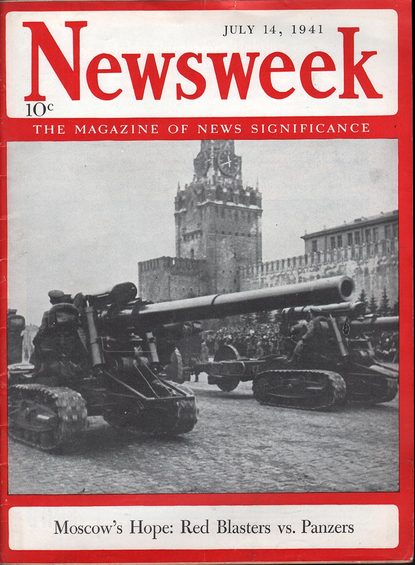 |
| Newsweek's 14 July 1941 cover story is "Moscow's Hope: Red Blasters vs. Panzers." Coincidentally, 14 July 1941 also is the day the Soviet Red Army first uses Katyusha rockets against the Wehrmacht. |
An exchange of prisoners also is required, but the British are upset when they learn that the French took many prisoners out of the country. Demanding their return, the British hold Vichy commander General Henri Dentz and 29 of his senior officers in detention in Palestine until they are handed over.
The Convention of Acre effectively ends the campaign in Syria and Lebanon. From a strategic perspective, this is a big win for the Allies because it ensures the safety of the oil route from Basra/Baghdad in Iraq to Haifa, Palestine. It also removes the threat of a concentric attack on Egypt should General Rommel's Afrika Korps make further advances.
 |
| Luftwaffe ace Joseph "Pips" Priller of I./JG 26 on 14 July 1941. |
After dark, RAF Bomber Command attacks Bremen with 78 Wellingtons and 19 Whitleys. They have three main targets:
- the Alstadt
- the goods station
- the shipyards
RAF Bomber Command also attacks Hannover with 85 aircraft, 44 Hampdens, 21 Wellingtons, 14 Halifaxes, and 6 Stirlings. The targets are a rubber plant and the city center. This attack also is considered a success, although two Wellingtons fail to return.
RAF Bomber Command also sends six Wellingtons to attack Rotterdam and 10 Hampdens on minelaying operations in the Frisian Islands and the Elbe.
RAF fighter ace James Lacey shoots down a Bf-109.
- 328 lost during daylight operations
- 672 lost during night operations
- 40,346 sorties total
- 3,737 daytime sorties
- 32,609 night-time sorties
- 4.2% casualty rate during daylight operations
- 2.1% casualty rate during night operations
 |
| Luftwaffe ace Joseph "Pips" Priller of I./JG 26 on 14 July 1941. |
Italian submarine Alessandro Malaspina torpedoes and sinks 3576-ton Greek freighter Nikoklis about 105 miles southwest of the Azores. There are 17 deaths.
The German 1st Motor Torpedo Boat Flotilla (S.26, 27, 28, 40, and 101) attacks a Soviet convoy off Ekholm, Finland without causing any damage.
The Luftwaffe bombs and sinks 1305-ton Swedish freighter Aspen 45 nautical miles (83 km) off Rotterdam/Ijmuiden. There are two deaths. Some accounts place this incident on 16 July.
British 5449-ton freighter Hannington Court catches fire about 9 miles south of Dyer's Island, South Africa, and is badly damaged. Later, because the drifting and abandoned ship is a navigational hazard, the Hannington Court is sunk by shellfire. There are two deaths.
Convoy OB-346 departs from Liverpool bound for Freetown.
Royal Navy anti-submarine warfare (ASW) trawler HMS Quadrille is commissioned, submarine Simoon is laid down.
US submarine USS Herring is laid down, and the keel is laid for USCGC Storis.
The Luftwaffe torpedoes and sinks 3147-ton British freighter Brodwal in Beirut Roads off Beirut, Lebanon.
The Luftwaffe also torpedoes and sinks 2370-ton Vichy French freighter Lesbian at Beirut, Lebanon. Some sources say that the ship is intentionally scuttled due to the Armistice.
Junkers Ju-88 bombers based on Crete attack Suez, damaging ships and harbor infrastructure. British troopship Georgic of Convoy WS-9A (Winston Special) is hit and set afire. The ship drifts to the beach, entangling itself with landing ship Glenearn on the way, which also is badly damaged. There are 26 deaths. Glenearn later has to be towed to Bombay in August 1941, while Georgic is out of action until March 1943, when it arrives in England for repairs.
Australian destroyer HMAS Vendetta runs supplies during the night along with British destroyer Hero. While tied up and unloading, an accident happens during which its hull is breached. It sails to Mersa Matruh anyway, where it undergoes temporary repairs and then heads to Alexandria.
An Axis convoy of five freighters departs Tripoli bound for Naples. The RAF sends Swordfish torpedo-bombers from Malta to attack, but they can't find the convoy.
At Malta, a Malta-based reconnaissance plane flown by Flight Officer Adrian Warburton is flying over Catania, Sicily on a routine reconnaissance flight when the Italians at an airfield mistake his plane for an Italian one. The ground crew flashes Warburton a green light to land on the field, so Warburton drops his wheels and pretends to make a landing approach. However, at the last second, he makes a strafing run on the planes parked along the runway.
 |
| Life Magazine, 14 July 1941, "Sand Sailing." |
Battle of the Pacific: German raider Komet makes a rendezvous with supply ship Anneliese Essberger.
Partisans: The uprising in Montenegro against Italian rule continues. Today, the rebels take Mojkovac, killing Italian gendarmes. The revolt (the 13 July Uprising) continues adding new supporters throughout the regime.
Applied Science: The MAUD Committee report, which states that an atomic bomb is feasible, finds its ways into the hands of Dr. Vannevar Bush, head of the Office of Scientific Research and Development, and Dr. James B. Conant, head of the National Defense Research Committee.
 |
| British papers, such as the 14 July 1941 News Chronicle, are full of news about the recent signing in Moscow of the Anglo/Soviet Pact. |
Japanese/Vichy French Relations: In Paris, Japanese Ambassador Kato asks Vice-Premier Darlan for French official recognition of the Japanese puppet regime in Nanking, China. Darlan vaguely replies that he will look into it. Kato also submits a list of Japanese demands for use of air and naval bases in southern French Indochina - which would come in handy for attacking Indonesia, Hong Kong, the Phillippines, and Singapore.
German/Spanish Relations: Spanish General Agustin Munoz Grandes, the commander of the Spanish volunteer Blue Division, flies to Berlin for talks regarding the Wehrmacht's use of the Blue Division on the Eastern Front.
Those futile telephone conversations continue until long past midnight; they only accomplish killing in field commands any desire to shoulder responsibility and waste everyone's time. The Fuhrer's eternal meddling in matters, the pattern of which he does not understand, are becoming more than anyone can stand.Halder follows this with a brief note that another Fuhrer order has just arrived regarding troop strength.
Amon Göth is promoted to the rank of SS-Untersturmführer.
American Homefront: In a game against the Chicago White Sox in Comiskey Park, Chicago, New York Yankees star Joe DiMaggio hits a single off of Sox pitcher Johnny Rigney. This extends his record hitting streak to 54 consecutive games.
 |
| Boston American, 14 July 1941. There were many false reports during World War II about Hitler jailing Reichsmarschall Hermann Goering - which did eventually come true, but not in 1941. |
July 1941
July 1, 1941: US TV Broadcasting Starts
July 2, 1941: MAUD Report
July 3, 1941: Stalin Speaks
July 4, 1941: Pogroms in Eastern Europe
July 5, 1941: Germans on Schedule
July 6, 1941: Australians Attack Damour
July 7, 1941: US Marines in Iceland
July 8, 1941: Flying Fortresses In Action
July 9, 1941: British Take Damour
July 10, 1941: Sword and Scabbard Order
July 11, 1941: Cease-fire in Syria and Lebanon
July 12, 1941: Anglo/Russian Assistance Pact
July 13, 1941: Uprising in Montenegro
July 14, 1941: Katyusha Rocket Launchers in Action
July 15, 1941: Smolensk Falls
July 16, 1941: Stalin's Son Captured
July 17, 1941: Heydrich Orders Mass Executions
July 18, 1941: Twin Pimples Raid
July 19, 1941: V for Victory
July 20, 1941: The Man Who Wouldn't Shoot
July 21, 1941: Moscow in Flames
July 22, 1941: Soviet Generals Executed
July 23, 1941: Secret Plan JB 355
July 24, 1941: Operation Sunrise
July 25, 1941: US Naval Alert
July 26, 1941: Italian E-Boat Attack on Malta
July 27, 1941: MacArthur Returns
July 28, 1941: Auschwitz Exterminations
July 29, 1941: Rescue From Crete
July 30, 1941: Raid on Petsamo and Kirkenes
July 31, 1941: Final Solution Order
2020




